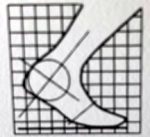Stiffness of the big toe joint is termed Hallux Limitus. Hallux is the medical term for the big toe. When the big toe possesses no motion, it is termed Hallux Rigidus. To confuse the topic, the big toe joint may appear to have normal motion, but this motion can be limited when weight is on the foot and during the normal gait cycle. This is termed functional Hallux limitus, because it occurs during the normal functioning of the foot while walking. As with many conditions that affect the foot, functional conditions progress to structural deformities. As the condition progresses, a degenerative type of arthritis develops in the big toe joint.
Diagnosis
The most common cause of Hallux limitus is an abnormal alignment of the long bone behind the big toe joint called the first metatarsal bone. In this condition, the first metatarsal bone is elevated relative to the other metatarsal bones that lie behind the other toes. When this is the case, the big toe joint cannot move smoothly and jamming occurs at the joint. A variety of symptoms can begin to occur. One common problem that occurs is pain in the bottom of the big toe where a central callus can develop. The pain and callus develop because the big toe does not bend upward enough as the bottom of the toe is jammed into the ground. People who have diabetes must watch this area carefully because the pressure can cause the development of an ulceration that can become infected.
Another consequence of the jamming of the big toe joint is the development of bone spurs on the top of the joint. This bump on the top of the big toe joint can become painful as a result of shoe pressure. Pain within the joint is a common result of the limitation of movement of the big toe joint. With time the big toe joint becomes stiff and painful to move. As the joint continues to degenerate more bone spurring occurs. If the condition is left untreated complete destruction of the joint can occur.
Diagnosis is made by performing a physical exam of the foot and the use of x-rays. In early stages of the condition x-rays may be normal. In later stages of the condition, narrowing of the joint and/or bone spurs may be evident.
Treatment
Initial treatment consists of using oral anti-inflammatory medications, cortisone injectionsand/or functional orthotics. Oral medications and cortisone injections are useful in treating the pain associated with the condition, but will not stop the process because they do not address the underlying cause of the condition. Functional orthotics, however, are designed to treat the cause of the condition. These devices will generally fit into normal shoes and correct the underlying functional problem with the joint. Orthotics will not reverse what damage may have occurred, but can slow or halt the on-going damage to the joint.
If the condition progresses to the point of spurring around the joint, surgery may be indicated. Depending upon the degree of degeneration of the joint, surgery may consist of simply removing the bone spurs around the joint or may require a total joint replacement (See surgery of Hallux limitus). Following surgery, the use of a functional orthotic is useful to improve the joint function.
If a painful callous exits on the bottom of the big toe it will frequently resolve and the pain subside with the use of functional orthotics and/or surgery to improve the motion of the joint.
